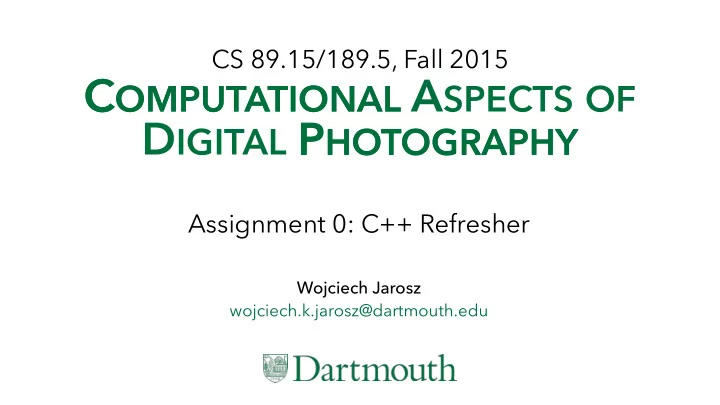

CS 89.15/189.5, Fall 2015 C OMPUTATIONAL A SPECTS OF C OMPUTATIONAL D IGITAL P HOTOGRAPHY P HOTOGRAPHY Assignment 0: C++ Refresher Wojciech Jarosz wojciech.k.jarosz@dartmouth.edu
First programming assignment Programming assignment 0 available on class website - just a warm up - familiarize yourself with C++ and the basecode - compile - change brightness/contrast of an image CS 89/189: Computational Photography, Fall 2015 2
C++
Why C++? More efficient than Java (compilation, memory) - Ridiculously more efficient than Python Standard language for many domains where performance matters (graphics, imaging) Good experience CS 89/189: Computational Photography, Fall 2015 Modeled after a slide by Frédo Durand 4
Online resources http://cs.brown.edu/courses/cs123/docs/ java_to_cpp.shtml http://www.cprogramming.com/java/c-and-c++-for- java-programmers.html http://www.horstmann.com/ccj2/ccjapp3.html and many more… CS 89/189: Computational Photography, Fall 2015 Modeled after a slide by Frédo Durand 5
Images in C++
Digital images Can be encoded as 3D arrays - 2D (x,y) grid of pixels - for each (x,y), have a number of channels (e.g. R, G, B) Formally: - Domain: 2D plane - Range: RGB space Other color spaces possible Values often encoded as 8- or 16-bit integers ([0..255] or [0..65535]) - But we will use floats in [0..1] to make life simpler CS 89/189: Computational Photography, Fall 2015 Modeled after a slide by Frédo Durand 7
Arrays C++ vector - dynamically sized - templatized by type, float in our case - e.g.: data = std::vector<float>(size, initialValue); Array3D (array3d.h) - our templatized wrapper to access a C++ vector as a 3D array CS 89/189: Computational Photography, Fall 2015 Modeled after a slide by Frédo Durand 8
1D to 2D vectors only have one 1D index 0 1 2 3 4 5 6 7 8 9 10 11 12 13 14 15 turn 2D index into 1D through strides - pixel at x,y stored at y*width + x 1D vector encoding 2D array 0 1 2 3 4 5 6 7 8 9 10 11 12 13 14 15 0 1 2 3 4 5 6 7 8 9 10 11 12 13 14 15 CS 89/189: Computational Photography, Fall 2015 Modeled after a slide by Frédo Durand 9
1D to 3D vectors only have one 1D index 0 1 2 3 4 5 6 7 8 9 10 11 12 13 14 15 3D array likewise for 3D where z is the color channel 18 19 20 9 10 11 0 1 2 21 22 23 - pixel at x,y,z stored at z*width*height + y*width + x 12 13 14 3 4 5 24 25 26 15 16 17 6 7 8 1D vector encoding 0 1 2 3 4 5 6 7 8 9 10 11 12 13 14 15 16 17 18 19 20 21 22 23 24 25 26 - other choices possible, e.g. y*width*depth + x*depth + z • why favor one over the other? CS 89/189: Computational Photography, Fall 2015 Modeled after a slide by Frédo Durand 10
Our FloatImage class Inherits from Array3D<float> Stores a vector of pixel values - size width*height*numChannels size & number of dimensions - could be used to represent 2D images with single channel, or even 1D arrays access data using operator(…), e.g.: image(x,y,z) CS 89/189: Computational Photography, Fall 2015 11
File formats We’ll use PNG - simple to read, no big library needed - only lodepng.(h|cpp) in ext subdirectory - easy to convert to/from other formats We’ll talk about how JPEG and other formats work later CS 89/189: Computational Photography, Fall 2015 12
Programming Assignment 0 Just a warm up familiarize yourself with C++, the FloatImage class compile change brightness & contrast of an image CS 89/189: Computational Photography, Fall 2015 13
Next… History of photographic technology CS 89/189: Computational Photography, Fall 2015 14
Slide credits Frédo Durand CS 89/189: Computational Photography, Fall 2015 15
Recommend
More recommend